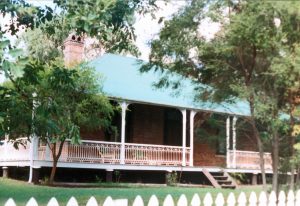QT 14/07/1922
FIRST COTTON CROPS (By “Red Gum.”).
Cotton is now styled “the goose that lays the’ golden egg’ for the farmer in Queensland.” Years ago during my youthful days it laid many a “golden egg” for the pioneer farmers of West Moreton, in which large agricultural area, the cultivation of cotton was carried on during the latter part of the ’60 and the early ’70 decades.
In its further comments on the production of the four bales above referred to the “S.M. Herald” of 60 years ago, said:- Our neighbours look no doubt upon their establishment as a separate colony as likely to advance their commercial interests, and it will certainly accomplish this if it arouses the settlers to sow their land with cotton seed and export the produce. We are warranted in anticipating this as one of the first fruits of separation. The cotton was grown by the late Mr. John Panton, one of Ipswich’s principal business men in the early days, on his plantation comprising 12 acres in the centre of the thriving suburb of Woodend, at the west end of this city, having a frontage to the Bremer River, and on the 17th of May, 1862, Mr. Panton wrote to the ” London Times” as follows:-“Having forwarded from Ipswich, via Sydney, four bales of Queensland cotton, I shipped per Light of Age, for London, and it being the first cotton exported from Queensland as an article of commerce, I am anxious to have it taken notice of, as I am clearly of opinion that this colony is capable of suppling any quantity of cotton required, with the assistance of labour and capital, which England can supply.
This cotton was grown by me at Ipswich on a piece of land of 12 acres. In the neighbourhood of this town the Ipswich Cotton Company have nearly 100 acres under crop, which promises a fair yield. A number of parties are now preparing their land for cotton next season.” Thus wrote Mr. John Panton in 1862. So the “cotton ball” rolled on. Sixty years ago the eyes of Great Britain and Europe were turned towards the young two-year-old Colony of Queensland, which then seemed destined to become one vast cotton-field, for, in consequence of the American War, great distress prevailed in the cotton manufacturing districts of Lancashire, and Manchester through the scarcity of cotton. The London “Times” wrote in reference to the Queensland Court at the International Exhibition of 1862:–“Queensland, the latest born of the Australian colonies, jukes an excellent show here, and, to judge from the variety of products exhibited, there are few colonies blessed with a more seductive soil, or greater diversity of resources. The first object which attracts attention on entering the court is the COTTON, of which there are numerous samples, and there can be no doubt that Queensland possesses an enormous area capable of growing cotton of .the best quality.”

